THE SEARCH FOR GRANDMA CHANA'S FAMILY
by Mark Halpern
THE SEARCH FOR GRANDMA CHANA'S FAMILY
by Mark Halpern
|
I
never knew my paternal grandparents. They both passed on before I was
born. My maternal grandfather, David PERLIS, never adapted to life in
the US. He left Bialystok in 1921 only because he was convinced that his
family would live better in the US, where siblings of his had lived for
20 years. His dislike of the US affected his relationship with his
grandchildren, with whom he had very little interaction. But Grandma Chana was the grandmother everyone would love. She was crippled from Rheumatoid Arthritis and the “cure” she tried crippled her more. My family lived downstairs from Grandma Chana until I was 6 years old. Then, until she died when I was 10, we spent every weekend with her. In spite of her constant pain, her life was spent making everyone around her comfortable. She was a beautiful person. |
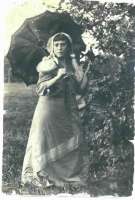 |
|
|
|
Fast
forward 40 years. I was in Warsaw on business and decided to visit Bialystok
just to see where my mother, my uncles, and my grandfather were born. I saw what
was left of Jewish Bialystok and my guide asked me about my family history. What
did I know? Turns out not much. I returned home, logged on to the Internet,
found JewishGen and, six years later, here I am. I have traced my paternal lines
back to about 1800 in Eastern Galicia. I have traced my maternal grandfather
David’s family back to about 1760 in Tykocin and Bialystok. But, where is the
history of Grandma Chana’s family? |
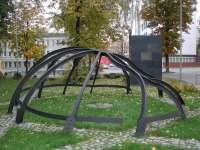 |
 |
|
| Memorial to Destruction of Great Synagogue | Memorial to Bialystok Ghetto Martyrs | ||
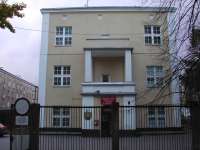 |
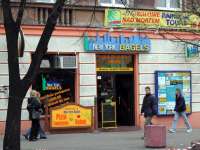 |
||
| Former Site of Hebrew Gymnasium | No Bialys, but New York Bagels |
I had two documents to help me. One was a Polish birth certificate of my mother that was issued in Bialystok for Educational purposes. This identified Chana’s father as Szamshel GIRSZOWICZ. The second document was a Polish passport issued to Chana for her and the children’s 1923 immigration to the US. The passport showed Chana’s town of birth as Pieszczaniki.
|
Polish [For Education Only] Birth Certificate of Necha Perlis Click for Larger Image |
Polish Passport of Chana Perlis issued 1922 Click for Larger Image and other pages |
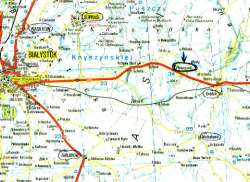 |
I
may have been 40 years late, but I found the Cemetery in New Jersey where, in
1956, Chana was buried. On the tombstone it said Chana bat Shamai HaLevi, the
name of my great-grandfather. A few years later I located Chana’s
naturalization papers and, more importantly, Chana’s death certificate. Here,
Grandpa David, as the informant, listed Shamai GERSHOWITZ and Judith CITRON as
Chana’s parents. On her naturalization documents was her birthplace,
Piesczanik. I was able to make
contact with the family of Chana’s sister in Tel Aviv. We in the US knew of
Chana’s sister, Fania. Fania’s
family knew of Chana. But nobody knew any more
-- a dead end. All attempts to locate vital records for Pieszczaniki were
futile. It appears that, if they exist, they are located at the Grodno, Belarus
State Archives that has not been friendly to genealogical inquiries. A native
son of Grodno, who became a friend when I lived in Los Angeles, could not obtain
information.
I am a very active volunteer with Jewish Records Indexing – Poland and a member of the Board of Directors. It was in this capacity that I visited Poland in October 2001. There was not much time for personal research as appointments with Polish Archives, Jewish Cemeteries, and Historical Societies/Museums in many cities were scheduled weeks in advance. But the schedule did provide two open days, which were just after visiting the Archives in Bialystok. This was my opportunity to research Pieszczaniki.
Before
I left for the trip I researched as much as I could. My research led me to
assume that the Grodek Jewish community must have been the one that included
Pieszczaniki in its sphere. I also found out that a CYTRON family was a
prominent textile manufacturer in Michalowo, a nearby town with a significant
Jewish presence. I had already known that many family members were in the
textile business, including Grandpa David a silk weaver both in Bialystok and
later in Paterson, New Jersey. |
|
|
Pieszczaniki, 28 KM East of Bialystok Click for larger image |
||
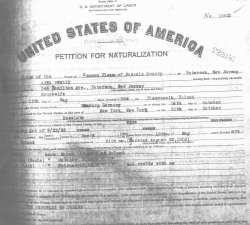 |
||
|
Chana PERLIS US Naturalization Born in Piesczanik Click for larger image |
I
had hired Piotr Rytka, a young Jewish man from Warsaw, to be my guide. He was
familiar with genealogical research and with Jewish Bialystok. He worked on
behalf of the Jewish Community of Warsaw filing restitution claims for Jewish
historical sites in Poland. We started out early in the morning one very
overcast day in October. It was our good fortune that we passed on the first
Taxi in the queue as we saw the driver smoking inside. The second Taxi driver
was born in Michalowo and knew the area very well.
|
We
left the city of Bialystok, and after only a 20-30 minute drive, arrived in
Pieszczaniki, which still had the feel of the early 20th Century.
Pieszczaniki is a small, sleepy village with no paved roads and no houses that
appeared to date to after WW2. We drove around a short time until we found a
resident. Mr. Grzes Arkadiusz, who was born in Pieszczaniki about 1933 and had
lived there all his life, told us that no Jews had lived in town but a Jewish
family lived just outside of town and operated a textile factory. Grzes told
stories of his friendship with the son, Lutek, and his father’s role
delivering fabric for sale in Bialystok. |
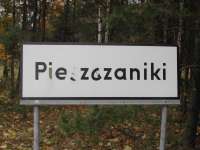 |
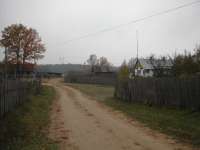 |
|
| Sign upon entry to Town | The Village of Pieszczaniki | ||
 |
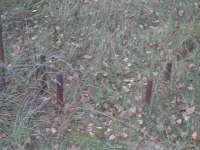 |
||
| Grzes Arkadiusz and Piotr Rytka on site of Textile Factory | Supports for Boiler -- Last Remnant of AMDURSKI Factory |
|
|
Grzes led us to two older residents, Stefania Germanska and his cousin,
Grzes Aleksander. Stefania worked at the factory as a teenager. I was
disappointed to hear that the
factory was owned by the AMDURSKI
family and these residents had never heard the names GIRSZOWICZ or CYTRON.
However, I wrote down all I heard about Feiwel AMDURSKI, his sons Abram and
Max, and their families. It was interesting to note that the children and wives
lived in Pieszczaniki only in summer, spending the rest of the year in
Bialystok. The original factory was built of wood in 1914. It was later
destroyed by fire and rebuilt of brick in 1928. When the Nazis occupied this
area, they shut down the factory and used the bricks for construction material.
After the war, the Soviets used the remaining bricks to fix a church in nearby
Grodek. The only remnant of the factory is eight steel rods sticking up from the
ground in the middle of a field – the support for the factory’s boiler. |
|
|
Grzes Aleksander & Stefania Germanska |
Grandma
Chana was born here in 1883 or 1884. By 1905, she was married to my Grandfather
and living in Bialystok. Before leaving the village, we were told that before
the large AMDURSKI factory was built, smaller textile factories dotted the main
road East from Bialystok. I can only assume that one of these factories was
where Shamai GIRSZOWICZ made his living. I left Pieszczaniki with the question
of how the AMDURSKI family was connected to my GIRSZOWICZ and CYTRON families.
|
Our
next stop was the town of Grodek, which is also the seat of Grodek Gmina
(County). We contacted the local civil records office (Urzad Stanu Cywilnego –
USC), where we were told there were
no Jewish records. Piotr and I were welcomed at the Grodek Cultural Society. Two
delightful women searched through the archives of the Society’s quarterly
publication. This publication includes articles about the three ethnic heritages
of the area; Russian Orthodox, Polish Catholic, and Jewish. They provided two
copies of all the publications with articles on Jewish history – one for
personal use and the other as a gift to the Jewish Historical Institute in
Warsaw. Only one article referred to the AMDURSKI factory saying it was a good
place to work. I
left Grodek with some disappointment. Although all the people we met were very
kind and helpful, with no sense of anti-Semitic attitudes that the press
associates with Poland, this stop provided no information about my family. The
only remaining Jewish landmark in Grodek is the Cemetery on the outskirts of
town. Most of the tombstones had been removed and none of the remaining Matzevot
could be read. |
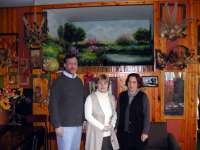 |
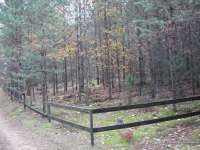 |
|
|
Mark Halpern with women from Grodek Cultural Society\ |
Grodek Jewish Cemetery | ||
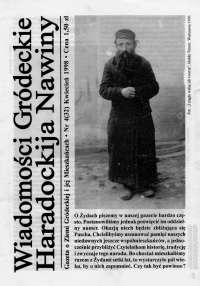 |
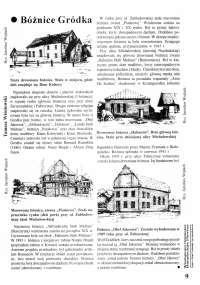 |
||
|
April 1998 Publication of Grodek Cultural Society Click for larger image |
Article about Synagogues of Grodek by Tomasz Wisniewski Click for larger image |
|
The
town of Michalowo is the county seat of the neighboring Gmina. Our first stop
was the Gmina civil records office (USC), where the woman we questioned told us,
as we suspected, that there were no Jewish records. However, this woman’s
mother had worked at the CYTRON factory before it burned down. She directed us
to the house of the widow of the late town Historian, Dr. Leszek Nos. We
purchased his book, published before his death in 1996. In the book was a
reference to Lipa CYTRON, who owned a textile factory in Michalowo until 1928,
when it was destroyed by fire. Was it a coincidence that the AMDURSKI factory,
only 7 miles away, was built in 1928 and the CYTRON factory was not rebuilt? Piotr and I then walked to the old Jewish market square. Much looked like it did before WW2. We then attempted to find the oldest person in the neighborhood. After talking with a few people we found Aleksander Kardasz, a very young and spry 90 year old man.
Aleksander’s
memory was first rate. He was able to tell me the names of Jewish students who
attended school with him – Lichtfeld, Izbodsky, Krugman, Epstein, Gerszuny,
and Polashinsky. His memory was vivid about the CYTRON factory. He said that
there was also a CYTRON factory in Suprasl and that descendants of the owners
still lived abroad. We
drove outside of town to the Jewish Cemetery. The ninety year old Aleksander led
the thirty something Piotr and the fifty something Mark up the hill to the
Cemetery without even exerting himself. There in a beautiful hilltop forest were
a good number of headstones, many of them worn and falling over. In the
distance, one Matzevah stood out – it was straight and the Hebrew was
readable. It was the grave of Yallev CYTRON, daughter of Abraham Itzchak HaCohen
and wife of Shmuel (or Shneur) Zalman. Was this a relative? |
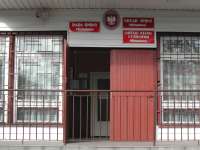 |
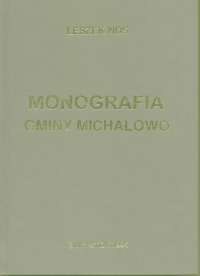 |
|
| Michalowo USC Office |
Monografia Gminy Michalowo by Leszek Nos |
||
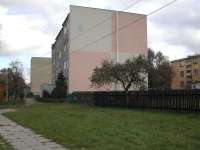 |
 |
||
|
Site of Former Cytron Factory in Michalowo |
90 Year Old Aleksander Kardasz with Mark Halpern |
||
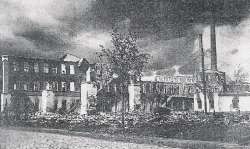 |
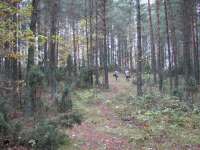 |
||
|
Remains of Cytron factory in Suprasl burnt down by the Nazis in 1942 Courtesy of Zchor.org |
Jewish Cemetery in Michalowo | ||
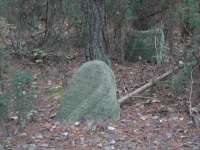 |
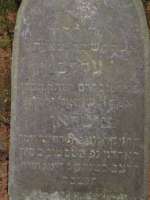 |
||
| Matzevot in Michalowo Jewish Cemetery |
Matzevah of Yallev CYTRON Click for Larger Image |
On my second day in Bialystok, I wanted to walk where once my ancestors walked. From Passenger List entries I had the addresses of my grandparents home in 1923 as well as my grandmother’s sister’s home and another cousin’s home. My grandparent’s home address was Polna 27. I had learned that this street’s name was changed from Polna to Warynskiego after the War. It turns out that this street was near the center of what became the Bialystok Ghetto. There were many old wooden houses of early 20th Century vintage, but where #27 should have been was a very typical Soviet era apartment complex. However, right across the street at #24A Warynskiego was the building that once housed the CYTRON Synagogue. I later found out that this Synagogue was built in the 1930s in honor of Szmuel and Chawa CYTRON by their four sons, Benjamin, Aleksander, Szymon, and Jefim. I wonder whether the site of the CYTRON Synagogue and Grandma Chana’s house were just a coincidence?
|
|
|
|||
|
Site of Former Residence at Polna 27 |
CYTRON Synagogue Building at Polna 24A |
With
this new information and many more questions, I returned to Warsaw. We had
meetings with several people at the Jewish Historical Institute. One of these
appointments was with the head of The Ronald S. Lauder Genealogy Project, Yale
Reisner. Yale was interested in my search for Grandma Chana’s family. He
provided a copy of an article on the Bialystok CYTRON family, written by Tomasz
Wisniewski, a journalist and well known historian of Jewish Bialystok. He also
provided copies of pages from a 1922 Polish Book of Addresses for Industry,
Trade, and Finance.
The
Wisniewski article talks about Samuel/Szmuel CYTRON and his family having 3
textile factories in Suprasl and the extended family living in Bialystok as well
as Suprasl, nearby Michalowo and Grodek, and Zabludow. He also mentions a
connection to Rene Aron CITROEN, who moved to France in 1908 to build
automobiles. I have talked to two distant cousins with CYTRON connections. Both
mentioned a connection to the French CITROEN automobile company.
|
|
|
|||
|
Article by Tomasz Wisniewski about Cytron Family |
1919 CITROEN Automobile |
|||
|
|
|
|||
|
Cover of 1922 Industry Address Book |
Cytron Suprasl Entry under Manufacturers of Woolen Goods Click for Larger Image |
The
listings in the 1922 Industry Address Book included ones for Fajwel CYTRON, a
wholesaler of cloth in Bialystok, Fajwel AMDURSKI, a dyer and finisher of fabric
in Bialystok, CYTRON, L. & Sons, a fabric manufacturer in Michalowo, and Sz.
CYTRON, a dress manufacturer in Suprasl. In the Suprasl entry one of the
Directors is listed as L. AMDURSKI. Is this the proof of a connection of the
Pieszczaniki AMDURSKI family to Samuel CYTRON, the benefactor of the CYTRON
Synagogue?
After
only a few days in Poland, I had much more evidence that Grandma Chana’s
CYTRON family was connected to the large CYTRON family in Bialystok and that the
connection of all the families was the textile industry.
I
returned home and searched through the Jewish Records Indexing -Poland indices
of Bialystok vital records covering the period 1835-1899. To my surprise, I
found the 1881 marriage of Szebsel AMDURSKI, son of Abram, to Szejna Itka
PENZUCH. Szejna Itka was a first cousin of David PERLIS, Grandma Chana’s
husband.
I
left the US with very little information and returned with a great deal of
circumstantial evidence that connects Grandma Chana to the AMDURSKI family of
Pieszczaniki, to the CYTRON family of Bialystok and Michalowo, and possibly to
the CITROEN family of France. As usual with genealogical pursuit, more evidence
is needed. On the trail again.
This research group, its mailing list, and this website are hosted by JewishGen, Inc. at no cost by JewishGen, Inc., the Home of Jewish Genealogy. If you have been aided in your research by this site and wish to further our mission of preserving our history for future generations, your JewishGen-erosity is greatly appreciated.
Copyright © 2004 BialyGen, Mark Halpern, Coordinator, All rights reserved.
Last Updated on 18 March 2005.